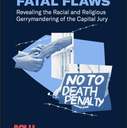
Long-running execution lawsuits have settled in Arizona and California, as a renewed challenge to the state’s revised lethal-injection protocol has ramped up in Oklahoma.
The Arizona settlement addressed issues of execution transparency, while the California settlement acknowledged the impact of the state’s execution moratorium and preserved death-row prisoners’ rights to oppose any new execution plan should the moratorium be lifted. The Oklahoma litigation raises concerns about the constitutionality of the state’s latest execution protocol and whether it complies with the terms of a prior court settlement.

The Arizona Settlement
Arizona’s settlement, reached on June 26, 2020, committed the state to allow witnesses to see and hear an execution in its entirety, while keeping the identity of its drug suppliers secret. The agreement implemented a September 2019 ruling of the U.S. Court of Appeals for the Ninth Circuit in a lawsuit brought by seven death-row prisoners and a coalition of media organizations in which both sides claimed victory. That ruling, in First Amendment Coalition v. Ryan, recognized for the first time that the public’s First Amendment right to witness an execution encompasses the right for witnesses to hear the execution in its entirety. The court also expressed concern with what it called “Arizona’s checkered past with executions” and said it was “troubled by the lack of detailed information [Arizona provided] regarding execution drugs and personnel.” But while it believed that “[s]uch information would undoubtedly aid the public and death-row inmates in monitoring the constitutionality of Arizona’s execution proceedings,” it said the First Amendment right of access to governmental proceedings did not extend to that information.
The law firm Sidley Austin LLP, which provided pro bono representation to the prisoners in the suit, issued a statement July 1 saying it had prevailed in a “precedent-setting capital punishment case,” permanently ending the state’s use of midazolam in executions, imposing “limits on the state’s unchecked discretion to deviate from its written lethal injection execution procedures in violation of prisoners’ due process rights,” and “bring[ing] transparency to Arizona’s often secretive approach to capital punishment.” Arizona Attorney General Mark Brnovich described the Ninth Circuit ruling as “a major victory” for the state, keeping the identities of the state’s lethal-injection drug suppliers “confidential and protected from harassment or retaliation from anti-death penalty activists.” In a July 15 press release, Brnovich claimed that the settlement “allows Arizona to move one step closer” to resuming executions after a six-year hiatus.
The Arizona lawsuit was filed in the wake of the state’s botched execution of Joseph Wood in 2015. Wood gasped, choked, and struggled to breathe for 1 hour 57 minutes behind a sound-proof window that separated witnesses from the execution chamber. The inability to hear and describe the sounds inhibited defense lawyers’ efforts to halt the execution. The petitioners in the lawsuit sought the right to see and hear the execution in its entirety and to reveal the identities of lethal injection drug suppliers. Under Arizona’s old execution protocol, execution witnesses could view through a video monitor the prisoner being strapped to the execution gurney and the insertion of the intravenous execution line. They could then observe through a window the administration of the execution drugs, but they could not hear the execution.

The California Settlement
On July 24, 2020, California death-row prisoners and the state Department of Corrections and Rehabilitation reached a conditional settlement ending the prisoners’ 14-year-old lethal injection lawsuit.
Noting that California had imposed a moratorium on executions and dismantled the state’s execution chamber, the prisoners voluntarily dismissed their challenge to the state’s execution process and agreed to vacate stays of execution that had barred the state from putting prisoners to death while the litigation was pending. In return, California agreed to provide the prisoners’ lawyers and the federal court advance written notice of any future Governor’s intention to withdraw the executive order imposing a moratorium on executions, adopting an execution protocol, or beginning to reassemble any facility to conduct executions.
The parties also agreed that the prisoners could reactivate the lawsuit if the moratorium is lifted, the state adopts an execution protocol, or any district attorney, court, or any other state actor seeks to set an execution date for any death-row prisoner. At that time, any death-row prisoner who had completed the appeals process would be permitted to join the lawsuit and seek a stay of execution until the renewed litigation is resolved.

The Oklahoma Lawsuit
As the execution-process lawsuits were being settled in Arizona and California, Oklahoma’s six-year-old lethal-injection lawsuit was being reactivated.
Executions in Oklahoma have been on hold for five years, after a series of botched executions in 2014 and 2015 and a last-minute stay when the state obtained an incorrect execution drug. The state legislature then adopted nitrogen hypoxia as an alternate method of execution, but Oklahoma was unable to obtain supplies of the gas or develop a protocol for its use to put prisoners to death.
On February 13, 2020, the state announced it would resume executions using the same set of drugs that had been authorized at the time of the botched executions: midazolam (a sedative), vecuronium bromide (a paralytic), and potassium chloride, which stops the prisoner’s heart. Less than two weeks later, the prisoners filed suit, calling the protocol “risky and incomplete” and saying that it failed to comply with the terms of an agreement put in place when executions were put on hold in 2015. Among other missing details, the protocol provided no information on how it would train the execution team to prevent future botched executions. Judge Stephen Friot of the U.S. District Court for the Western District of Oklahoma ordered the state to provide those details to the prisoners by June 5, and set a July 6 deadline for prisoners to respond. Judge Friot announced at that time that Oklahoma had agreed not to seek any execution dates while the lethal-injection litigation was still pending.
After the state submitted its supplement to the protocol, the prisoners, on July 6, filed an amended complaint alleging that the protocol does not comply with the settlement agreement and violates the First, Fifth, Sixth, Eighth, and Fourteenth Amendments. The amended complaint reasserts some of the previous claims against the protocol, supported by new evidence that the state’s intended three-drug method creates “significant risks of pain and suffering.” The complaint alleges that midazolam fails to render the prisoner insensate and “poses an objectively intolerable risk of substantial harm that is sure or very likely to occur.” In addition, it challenges the training protocols, which it says are “unclear and incomplete.” It also argues that the protocol gives “unfettered discretion” to the Director of the Oklahoma Department of Corrections, allowing changes to the protocol, including the drugs to be used, until ten days before the execution.
On July 27, the state filed a motion to dismiss the prisoners’ lawsuit. The court has set an August 10 date for a scheduling conference in the case.
Emma Cueto, Sidley Austin Secures Ariz. Death Penalty Reforms, Law360, August 2, 2020; Dylan Goforth, Attorneys file new complaint on behalf of Oklahoma death row inmates hoping to stop resumption of lethal injection, The Frontier, July 6, 2020; Dylan Goforth, Oklahoma releases execution training protocol to attorneys for death row inmates, The Frontier, June 5, 2020.
Read the statements of the Arizona Attorney General and the Sidley Austin law firm. See the Third Amended Complaint in Glossip v. Chandler (Oklahoma) and the California settlement agreement in Morales v. Diaz.



